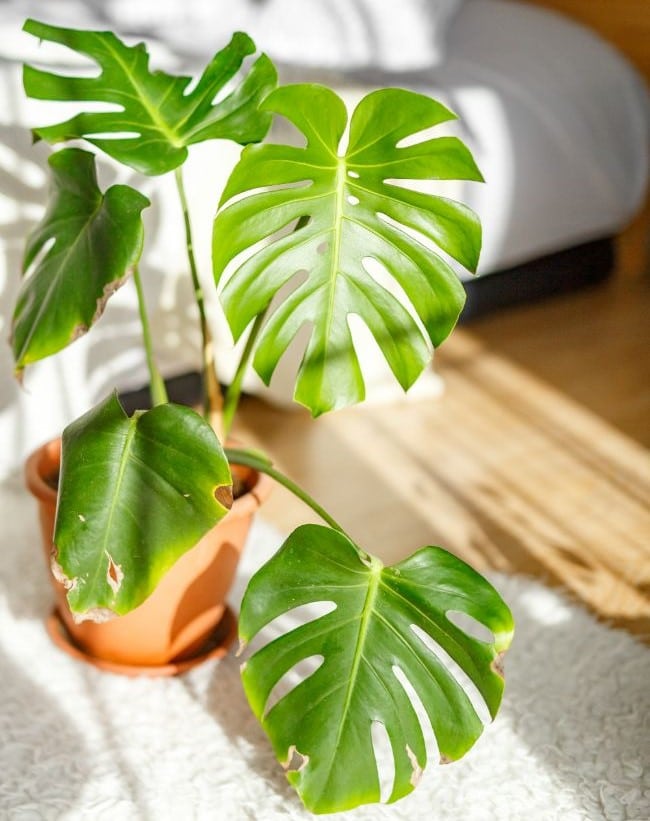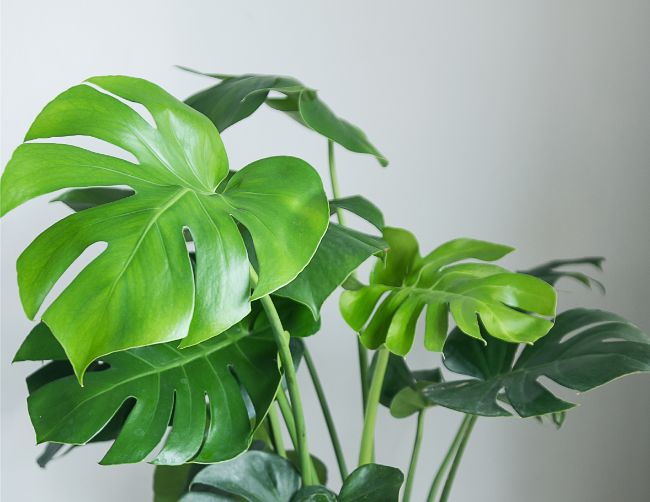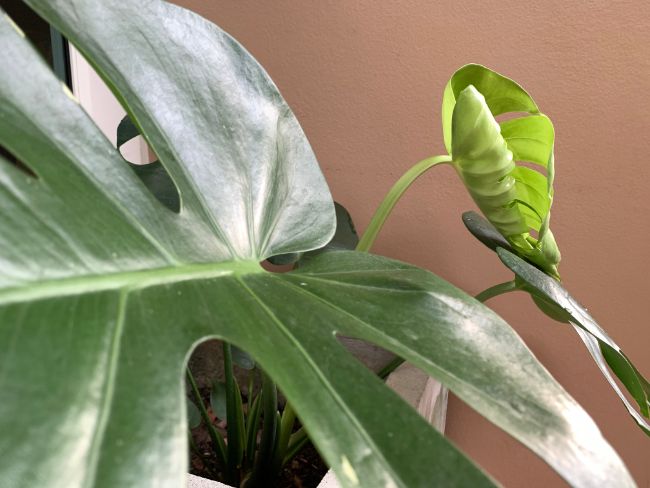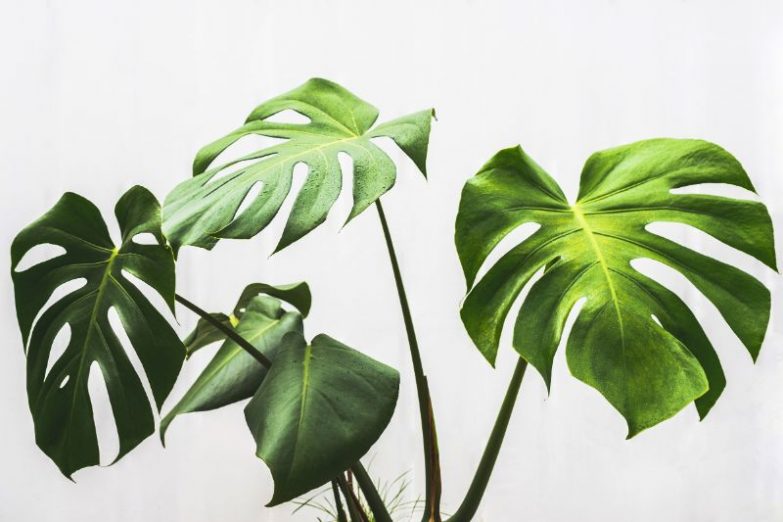With large, exotic foliage, Monstera plants make a strong impression in any indoor space. Keeping the leaves looking great isn’t too hard, but there are a number of common problems to watch for. This article is going to cover the causes of Monstera leaves curling and show you how to fix them.
Monstera leaves curling is usually a sign of underwatering or low humidity. Other causes include overwatering, pest infestations, heat stress, or your Monstera being rootbound. The tight curling of new leaves is normal before they unfurl.
Read on and I’ll go through each issue, in turn, to help you work out how to fix your Monstera plant.
6 Causes Of Monstera Leaves Curling And How To Fix Them
Monstera deliciosa and other Monstera species react to excessive water loss by curling their leaves to reduce their surface area and reduce transpiration. It is a normal adaptive measure of Monsteras and many other houseplants but is also a sign that your plant is experiencing stress.
Any factor that increases water loss or reduces the amount of water getting to the leaves can trigger Monstera leaf curling. Let’s look at each cause in turn. I’ll discuss the symptoms to look for, as well as the steps you can take to correct the problem and restore your plant to perfect health.
Underwatering
If you haven’t been watering your Monstera enough, then it will respond by curling its leaves. It is one of the most common causes of Monstera leaves curling and should be the first thing you investigate. Look for very dry soil, brown, crispy leaf tips and edges, and evidence of drooping. The plant pot should feel much lighter than normal due to the lack of water.
The simple solution here is to give your Monstera a thorough watering. Soak the soil fully until water drains freely from the drainage holes in the bottom of the pot.
Going forward, try to get into a routine of checking your Monstera to see if it needs to be watered. Check the condition of the foliage and dryness of the soil every few days and water once the top 1-2 inches of soil feels dry to the touch.
Try to avoid watering your plant on a schedule, as the water requirements will vary depending on a range of factors, including the growth rate of the plant, time of year, ambient temperature and humidity, and the size of the plant in relation to the pot. Read my guide to watering houseplants for some great tips to help you keep your houseplants in perfect condition.
If you are forgetful when it comes to watering your houseplants, try setting a reminder on your phone every few days to help you check your plant on a regular basis.

Low Humidity
Many of the popular houseplants we grow originate from the understorey of tropical rainforests, where there are consistent temperatures and high levels of humidity.
Our homes are typically much more arid, and many houseplants struggle to cope with these lower levels of humidity. Monstera leaves curling is a common response to low humidity levels.
Although more tolerant than some other popular houseplants, Monsteras do best with humidity of >40%, and will typically develop leaf curling, and brown leaf tips and edges with humidity much below this. Some less common Monstera species require extremely high humidity levels to keep them looking well.
You can differentiate between Monstera leaves curling due to low humidity from an underwatering problem by the following;
- Check the soil. If the soil remains damp, underwatering is unlikely.
- Your Monstera is unlikely to wilt if the problem is soley due to low humidity.
- Use a digital hygrometer/thermometer to monitor humidity levels in your home. If humidity is consistently above 40%, then low humidity is not the cause of the problem.
There are a number of ways you can increase humidity levels in your home to benefit your Monstera and your other houseplants.
- Group your plants together to create a humid microclimate due to plant transpiration.
- Use a humidity tray under your Monstera. Using a wide-based drip tray filled with water works well. Use scattered pebbles to ensure that the base of the pot sits just above the level of the water.
- Use a humidifier to easily and rapidly increase the humidity level. Many models allow you to maintain your desired humidity level. This humidifier is a fantastic option for houseplants.
- Read my article about increasing humidity for indoor plants to learn more.
Pests
Monstera plants are not very susceptible to houseplant pests, but they can suffer infestations from time to time. Sap-suckers such as spider mites, mealybugs and thrips will feast on the foliage and stems, sucking the juices from the plant.
Curling of Monstera leaves due to pests is caused by the loss of water from the leaves by these pests. Although the plant may be absorbing ample water and nutrients from the soil, the pests feeding on the plant deplete these before they reach the periphery of the leaves. This results in Monstera leaves curling as if they were being underwatered.
Look for the pests themselves by inspecting the top and underside of the leaves and stems closely. Most pests will be spotted if you look closely, but spider mites are very tiny and can sometimes be missed. Look for wisp-like webs between the foliage, or use a magnifying glass to get a really close look at the leaves.
You may also see where the pests have fed on the leaves. Small yellow spots or rings on the leaves in an irregular pattern is a telltale sign that a pest has been feeding on your plant.
How To Treat Pests Causing Monstera Leaves To Curl
Pests are much easier to treat when the infestation is mild. Check your plants regularly for pests as part of your routine care.
If you identify, or suspect a pest problem, isolate that plant from the rest of your houseplants. One plant being affected is bad, but all your plants being affected is a real problem.
When you buy a new plant, keep it well away from your other plants for at least 7-10 days until you are sure there are no hitchhiking pests on board.
There are a range of treatment options for pests on Monsteras, but the treatment often depends on which pest you have and your preferences. I have written a complete guide to identfying, treating and preventing common houseplant pests which should provide all the information you need.

Heat Stress
High temperatures or warm drafts can result in Monstera leaves curling. This can happen quite quickly and is more likely to happen as an acute response to a sudden change in conditions.
Unseasonably hot weather, or moving your plant to a location where it is in the path of a heating vent can cause this problem. The heat and airflow causes much more rapid water loss from the leaves than it is used to, resulting in the leaves curling in a desperate attempt to hold onto some water.
Bear in mind that as the seasons change, you can encounter this problem. A Monstera that is perfectly happy in an east-facing window for most of the year, may encounter much more difficult conditions during a heatwave in the middle of summer.
Looking after houseplants requires you to keep your eyes open to the ever-changing conditions, and responding as best you can to keep your plant in good health.
Unsuitable Pot Or Being Rootbound
Sometimes you may struggle to identify why your Monstera leaves are curling, and in this case, you should consider the pot it is in. If your Monstera has grown large but is still in a small pot, it may use all of the water it is given very quickly. The plant may have become very rootbound, which will make it much more difficult to meet the watering needs of your plant.
If the soil feels dry only 1-2 days after you water your Monstera, then the pot and soil is probably not retaining enough moisture, and you should think about repotting. You may also see many roots growing out of the drainage holes, and when you lift the plant out of its pot, the roots will be tightly packed and wound around the inside of the pot.
Repot into a container that is 1-2 inches larger as this will give the roots new space to grow into, and provide more soil to retain water and nutrients in between watering. See this article about repotting root bound plants for a step by step guide.
Overwatering
This problem seems like an unusual cause of Monstera leaves curling, but it is potentially the most serious. It can also be the one that catches you out and leaves you with a very sickly plant.
Overwatering can sometimes mimic the symptoms of an underwatered plant, including curling leaves. This happens because constantly soggy soil results in the roots dying and stops water being absorbed by the plant, causing wilting.
In contrast to underwatering, the soil will feel wet, and there are a number of other signs to help you tell the two apart. An overwatered Monstera will often have generally yellowing leaves and will wilt. See this article for more information about yellow leaves on Monstera plants. The leaves may curl, but there are unlikely to be brown tips or leaf edges and they will not be crispy or dry.
For a plant with severe symptoms, root rot is usually present, so examining the roots will usually help you make the diagnosis. You may need to lift the plant from the pot to check the roots. Brown or black, mushy roots, often with a smell of decay is a telltale sign of root rot.
You will need to take immediate action to remove the affected roots and repot the plant for it to stand any chance of survival. Read my guide to identifying, treating and preventing root rot here for more information.
New Leaves

It is worth mentioning that there is one cause of curling that is totally normal and should not cause any concern. Whilst this may be very obvious, new leaves are curled up tight when they first emerge, before slowly unfurling. New leaf growth is a wonderful sign of a happy plant.
Last Word
Monstera leaves curling is usually a sign of a problem that can quite easily be fixed. Check your plant for signs of underwatering and low humidity first before checking thoroughly for the other problems. Look at the plant closely, inspecting the foliage and the soil, before considering how it is potted and the conditions it is experiencing.
With a bit of time and thought, it is usually possible to determine the cause of Monstera leaves curling correctly, allowing you to make some changes to get your plant back to full health.
If you’d like to become an expert at growing beautiful houseplants, check out my book, Houseplants Made Easy. I cover all aspects of houseplant care as well as how to identify, fix, and prevent all of the common issues. I will teach you the process I use to really understand your plants’ needs and help you grow stunning houseplants.

